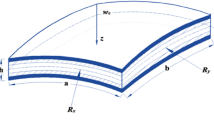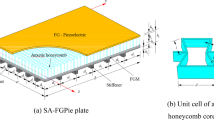Abstract
Purpose
According to the structural parameters of an actual turbofan aeroengine, the dynamics modeling and vibration analysis of multi-stage blade-disk-shaft integrated structure with three-dimensional crack are conducted.
Methods
Based on the theory of fracture mechanics, the stress intensity factor is considered as a fracture criterion. This paper proposes a three-dimensional (3-d) equivalent notch model which is simpler and more convenient than the traditional crack simulation model. Moreover, its validity is analyzed. Aiming at the harsh working environment of the blades, the penetration crack is considered at the edge and the middle of a blade root, respectively.
Results
The influence of the crack on the strength failure of the rotor system is studied. Results show that the appropriate small angle equivalent notch model can be convenient and effective to simulate the fracture cracks, in which 5° is proved to be the best angle.
Conclusions
The crack aggravates the vibration of blades obviously. A parametric study is conducted, with a particular focus on the effects of pressure load and centrifugal load on the stress intensity factors and displacement fields.


















Similar content being viewed by others
References
Wauer J (1991) Dynamies of Craeked rotating blades. Appl Mech Rev 44(1):273–278
Dimarogonas AD (1996) Vibration of cracked structures: a state of art review. Eng Fract Mech 55(1):831–857
Moes N, Dolbow J, Belytschko T (1999) A finite element method for crack growth without remeshing. Int J Numer Meth Eng 46(1):131–150
Silva FS (2005) The importance of compressive stresses on fatigue crack propagation rate. Int J Fatigue 27(10–12):1441–1452
Elber W (1971) The significance of fatigue crack closure. ASTM STP 486(1):230–242
Zeng J, Ma H, Zhang W et al (2017) Dynamic characteristic analysis of cracked cantilever beams under different crack types. Eng Fail Anal 74:80–94
MA Hui, WU Shuang, ZENG Jin, et al. Damping characteristics analysis of straight crack cantilever beam system. J Northeastern Univ 2017(4).
Wang, Shuai, Zi, Yanyang, Wan, Zhiguo, et al. (2015) Effects of multiple cracks on the forced response of centrifugal impellers. Mech Syst Signal Process 60/61: 326–343.
Dotti FE, Cortinez VH, Reguera F (2015) Non-linear dynamic response to simple harmonic excitation of a thin-walled beam with a breathing crack. Appl Math Model 40(1):451–467
Avramov K, Raimberdiyev T (2017) Bifurcations behavior of bending vibrations of beams with two breathing cracks. Eng Fract Mech 178:22–38
Giannini O, Casini P, Vestroni F (2013) Nonlinear harmonic identification of breathing cracks in beams. Comput Struct 129:166–177
Shankar KA, Pandey M (2016) Nonlinear dynamic analysis of cracked cantilever beam using reduced order model. Proc Eng 144:1459–1468
Liu J, Zhu WD, Charalambides PG et al. (2016) A dynamic model of a cantilever beam with a closed, embedded horizontal crack including local flexibilities at crack tips. J Sound Vib
Agarwalla DK, Parhi DR (2013) Effect of crack on modal parameters of a cantilever beam subjected to vibration. Proc Eng 51:665–669
Jassim ZA, Ali NN, Mustapha F et al (2013) A review on the vibration analysis for a damage occurrence of a cantilever beam. Eng Fail Anal 31:442–461
Barad KH, Sharma DS, Vyas V (2013) Crack detection in cantilever beam by frequency based method. Proc Eng 51:770–775
Aladiev V (2013) Damage and crack detection methods based on the vibrational characteristics of damaged and cracked cantilever beams. Dissertations Theses—Gradworks 03(2):27–32
Xin-ling L, Jia-sheng Z, Pei-dao Z et al (2005) Fracture failure analysis of the third-class turbine vanes in some engine. Materials Mech Eng 29(8):67–70
Yu-li Gu, Chang-kui L (2013) Crack analysis for 1st-stage blade of a gas turbine engine. Heat Treat Met 38(7):113–117
Zhi-gang C (2011) Crack analysis on aero-engine stator-blade. Heat Treat Met 36:42–44
Jian-jun C, Huai-chang Z, Guo-chao D (2007) Analysis of the cracks in the blades of low-pressure stage of 135MW steam turbine. Water Conservancy Electric Pow Ermachinery 29(4):1–4
Xiao-bo L, Qi-bai H (2005) Experiment study of the fault diagnosis for the spreading rotor blade cracks. J Huazhong Univ Sci Technol 33(9):50–52
Wen-wei T (2013) Failure analysis of cracks of fan blade in an aeroengine. Failure Anal Prev 8(2):112–116
Change-jian W (2013) Failure analysis of cracks of fan blade in an aeroengine. Failure Anal Prev 8(2):112–116
Chunwang Li, Xiuqin L, Baiyu Y et al (2013) Calculation of stress intensity factors for aero-engine blades based on finite element method. Chin J Appl Mech 3:373–377
Li Chunwang Wu, Xiaoliang CQ et al (2016) Study on the fatigue crack propagation law of aero-engine compressor blades. Chin J Appl Mech 3:384–388
Bo Z, Yanan Z, Linlin W et al (2017) Research on crack propagation mechanism of wind turbine blade based on fluid-structure coupling. Fluid Mach 08:27–31
Shahani AR, Kheirikhah MM (2007) Stress intensity factor calculation of steel-lined hoop-wrapped cylinders with internal semi-elliptical circumferential crack. Eng Fract Mech 74(13):2004–2013
Hongwei N, Min W (2018) A method for fault diagnosis of blade crack based on harmonic response analysis. Mech Res Appl 31(05):27–29
Lili Ma, Liqiang He, Weifeng R (2018) Analysis of blade failure of aeroengine free turbine blades. Aero Engine 44(06):58–62
Yang W, Lang Z, Tian S (2015) Condition monitoring and damage location of wind turbine blades by frequency response transmissibility analysis. IEEE Trans Industr Electron 62(10):1–1
Mian J, Wenan Z, Ji-gang WU et al. (2018) A blade crack location method using nonlinear estimation of vibration response. Mech Sci Technol.
Rzadkowski R (2018) Dynamic multi-stage analysis of a mistuned aircraft rotor with foreign object ingestion. J Vib Eng Technol 6(5):339–355
Rzadkowski R, Kubitz L, Maziarz M, Troka P, Dominiczak K, Szczepanik R (2020) Tip-timing measurements and numerical analysis of last-stage steam turbine mistuned bladed disc during run-down. J Vib Eng Technol 8:409–415
Kubitz L, Rzadkowski R (2018) LP last stage steam turbine blade vibrations due to mistuning. J Vib Eng Technol 6:309–316
Zeng Q, Liu H, Lim CW, Luo W, Yang Y (2011) Computation of aerodynamic performance for horizontal axis wind turbine based on improved blade element momentum theory. Proc CSEE 31(23):129–134
Funding
This project is supported by the National Science Foundation of China (No. 51805076, No. U1708255 and No. 51775093), the Fundamental Research Funds for the Central Universities (No. N170503011) and the Natural Science Foundation of Liaoning Province, China (No. 20180551058).
Author information
Authors and Affiliations
Corresponding authors
Ethics declarations
Conflict of interest
The authors declare that they have no conflicts of interest to this work.
Additional information
Publisher's Note
Springer Nature remains neutral with regard to jurisdictional claims in published maps and institutional affiliations.
Rights and permissions
About this article
Cite this article
Li, Z., Zhao, T., Kou, H. et al. Vibration Characteristics of Multi-Stage Blade–Disk–Shaft Integrated Structure with Three-Dimensional Crack. J. Vib. Eng. Technol. 9, 597–611 (2021). https://doi.org/10.1007/s42417-020-00251-0
Received:
Revised:
Accepted:
Published:
Issue Date:
DOI: https://doi.org/10.1007/s42417-020-00251-0




